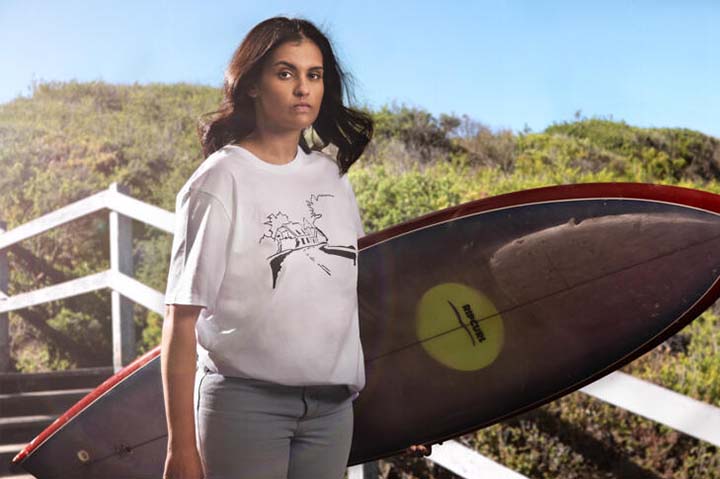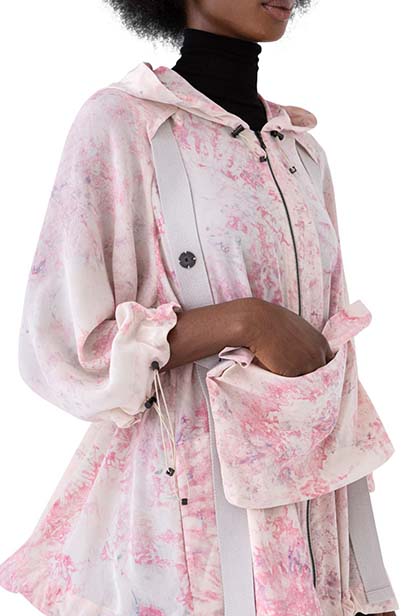Sustainability November 22, 2023
3 Trends in Sustainable Apparel
Bacteria-dyed fabric and shoe takeback programs are among the recent innovations.
Researchers are exploring new ways to decorate clothing – whether it’s using bacteria to create a one-of-a-kind dye job, grinding up old textiles to create a pigment that can be used for screen printing new designs, or simply launching a takeback program to ensure that used products don’t end up in a landfill.
Giving Textiles New Life

Artists used pigments created from recycled textiles to design new tees.
Researchers at a university in Australia have figured out a way to recycle textiles into a pigment that can be used to print other garments. Deakin University recently demonstrated these “Perpetual Pigments” at an exhibition that featured screen-printed T-shirts, designed by indigenous artists and produced in collaboration with surf brand Rip Curl.
Rangam Rajkhowa, an associate professor at Deakin, said that about 800,000 tons of textile waste ends up in Australian landfills each year, but he hopes his pigment extraction process can provide new ways that discarded clothes and other textiles can be reused in the circular economy.
“We’ve found that particles produced from textile waste segregated by color could be used for a range of applications. This includes pigments for printing or coloring textiles, and which can also be used to create art,” Rajkhowa said. “Our simple but powerful approach could address the huge challenges of recycling textiles due to complexities of different colors, fibers and blends.”
The Deakin research team grinds down textile waste – sourced from industry partner Textile Recyclers Australia – turning the fabric into a fine powder. Artists were given the recycled pigments in various colors and asked to experiment and provide feedback on them.
“We wanted to explore what’s possible,” said Dr. Russell Kennedy, co-curator of the Perpetual Pigments exhibit. “We hope this is the first step in developing new ways that waste textiles can be given a beautiful second life.”
Crocs Get Circular

Crocs has launched a takeback pilot program.
Crocs wants your old shoes. The brand recently launched a new retail takeback pilot program, inviting consumers to bring their old Crocs to stores in select states. Crocs will then leverage partnerships and product innovation to give the donated shoes a next use.
Participating stores are equipped with a designated collection box, and participants will receive a free, limited-edition “Crocs Saver” charm as a thank you, while supplies last.
“We’re excited to take this next step on our path toward innovating for a circular economy and a better future for footwear,” said Deanna Bratter, vice president, global head of sustainability at Crocs. “This pilot program aims to address both environmental and social challenges faced by the fashion industry when it comes to product waste. Together with our fans, we can unlock innovation and partnerships to effectively reduce waste, reuse our materials, keep shoes out of landfills and help people in need.”
Gently used Crocs received in the pilot will be donated to Soles4Souls, a nonprofit that distributes shoes and clothing donations around the world. Crocs that are too worn or damaged will be repurposed and reimagined – possibly upcycled into new Croc shoes.
Eventually, the company says it wants to scale the program to all U.S. Crocs retail and online stores.
“Our responsibility extends beyond the sale of our product. We want to keep Crocs products in use for as long as possible,” Bratter said.
A Jacket With Culture

This jacket was dyed using a pigment-producing microbe. (Courtesy of Normal Phenomena of Life)
You might have heard of algae ink – a more-sustainable alternative to carbon black pigment – but what about using bacteria to create a one-of-a-kind dye? Normal Phenomena of Life (NPOL), which calls itself the world’s first biodesign-native lifestyle brand, did just that, with its silk Exploring Jacket, batch-dyed with wildtype Streptomyces Coelcolor, a pigment-producing microbe that creates “bespoke patterns ranging from blue to red in color,” according to the NPOL website. The jacket is made of 100% GOTS-certified organic silk, using the toxin-free, water-efficient microbial dye process.
Also available on the site is a face oil made of fungi and T-shirts screen printed with algae-based ink.
Natsai Audrey Chieza, of design research lab Faber Futures, explained the impetus for launching the NPOL brand in design magazine Wallpaper: “We need to change everything, including consumer expectations of what products should be.”
“NPOL offers a unique opportunity to merge cutting-edge biotechnology with standout product innovation and storytelling,” she added.

Promo for the Planet is your destination for the latest news, biggest trends and best ideas to help build a more sustainable and socially-responsible industry.
